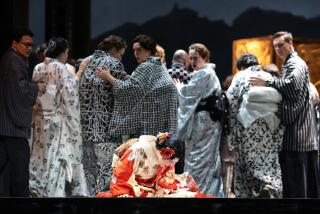Opera review: ‘Carmen’ at the Hollywood Bowl
- Share via
“Carmen” is not new to the Hollywood Bowl. On July 8, 1922, three days before the first season of “Symphonies Under the Stars,” the Los Angeles Philharmonic, itself only 3 years old, mounted a lavish production of Bizet’s opera. The cast numbered nearly 500. Massive sets of Seville surrounded the brand-new amphitheater. When soprano Marguerita Sylva, who starred, rolled into Union Station five days earlier, reporters were there to greet her as if she were a movie star. Proceeds from the performance financed the installation of the Bowl’s first benches.
Eighty-six years later, the Philharmonic’s concert performance of “Carmen” on Sunday night was not so grand. Rather than sets, the Bowl now relies on video close-ups of singers. Denyce Graves, the Carmen, had managed to slip into town under the radar of the paparazzi. Nor is this most popular of operas, which was first performed in 1875, any kind of novelty anymore. Luigi Nono’s “Intolleranza” -- still categorized as musically avant-garde and politically provocative -- is about the same age today as the once radical “Carmen” was at its Bowl premiere.
But if Sunday’s “Carmen” was no spectacle, it was not without flair. Graves generated, and inspired, enough flamboyance that she needed a straight man. That was Bramwell Tovey, who began his first season as the Philharmonic’s principal guest conductor at the Bowl last week. Instead of offering his typical amusing remarks, he merely read the synopsis of each act. (The Philharmonic now has the capacity to subtitle the video screens, which it did for “Carmina Burana” on opening night, but it chose not to Sunday, since the performance started at 7:30 and for the first hour natural light washed out the video.)
The opera was trimmed of dialogue but not of drama, with a cast prepared to ham things up in the manner of their favorite television sitcom -- which, for the gypsy women at least, seemed to be “Sex and the City.” Tovey relied on a clear stick technique to keep the shtick from wrecking tricky ensembles and to generally move things along.
A lot of this was a mess, nonetheless. A dozen years ago, Graves, then in her early 30s, was being hailed as the dream Carmen. A beautiful woman, she moved well, and her luscious mezzo-soprano oozed sex, especially in its rich lower range. Sirens became her trademark, her other most famous opera being Saint-Saëns’ “Samson and Delilah,” which she sang with Los Angeles Opera in 1999. She has also stretched; she created the title role in Richard Danielpour’s “Margaret Garner” a few years ago.
But she seems to have squandered at least some of her great promise. Her Carmen now, especially without a stage director to keep things in check, verges on the camp. She wore four flamboyant gowns, one for each act, beginning with a tight mermaid number but growing more tasteful as the opera progressed. Her voice remains rapturous in the low range, and it has not lost the power to thrill. But at an age when she should be in her vocal prime, she appears to be neglecting technique. Her intonation was such Sunday that, in a couple of places, she might as well have been singing Nono’s atonal opera.
Even so, Graves completely dominated the evening and a cast of emerging singers. She covered a huge distance of overacting, from strumpet to overwrought tragedian. And she inspired everyone to go along with her.
Stuart Skelton’s Don José was more milquetoast than most tenors who sing the role, but he has a fervent, lyrical instrument, and he sang his heart out. Jessica Rivera, as good girl Micaëla, was passionate but lacked the dramatic intensity that has made her so impressive in John Adams’ recent operas. Mariusz Kwiecien brought a big baritone as the toreador Escamillo but no swagger. Graves dwarfed them all.
The many young singers in smaller roles were uneven, and most would have been better off had they been in a position to watch Tovey. Both the Philharmonic and the Pacific Chorale sounded in need of more rehearsal. The Los Angeles Children’s Chorus sat patiently onstage with little to do, but the kids were on the ball when called upon.
More to Read
The biggest entertainment stories
Get our big stories about Hollywood, film, television, music, arts, culture and more right in your inbox as soon as they publish.
You may occasionally receive promotional content from the Los Angeles Times.











